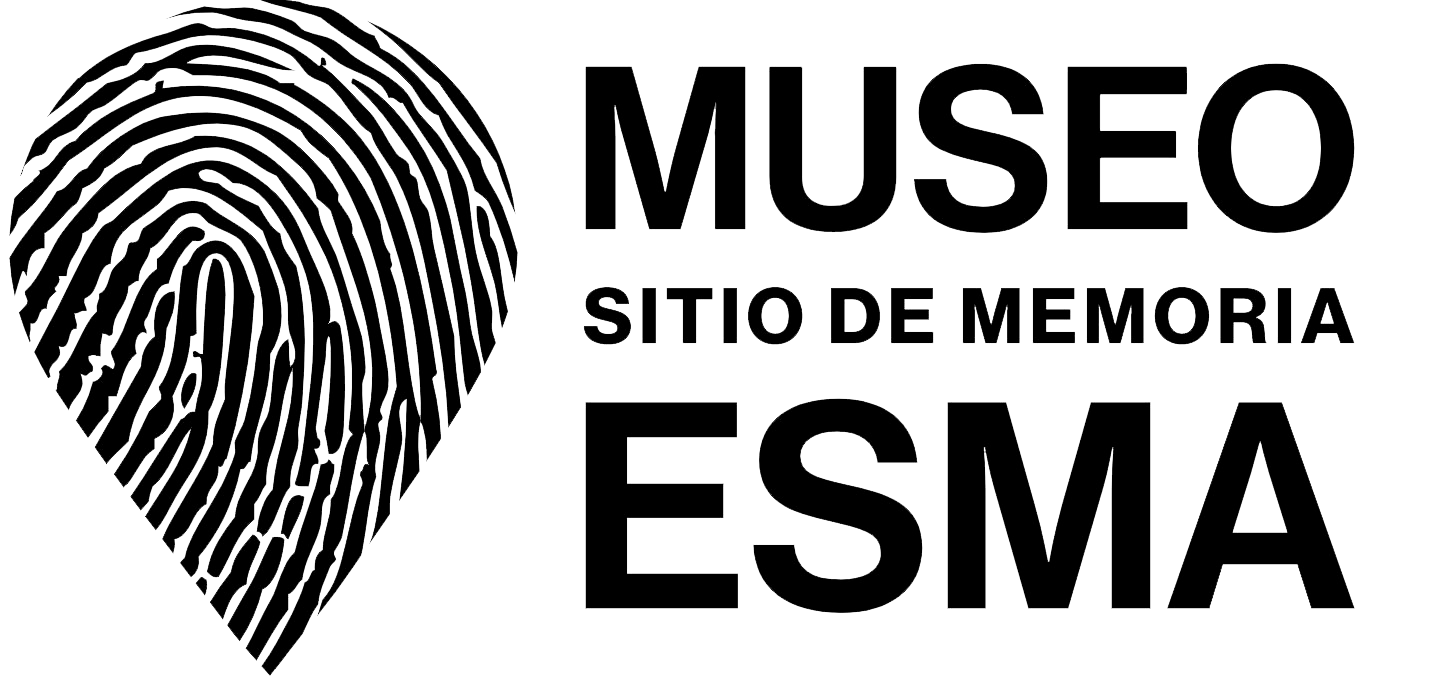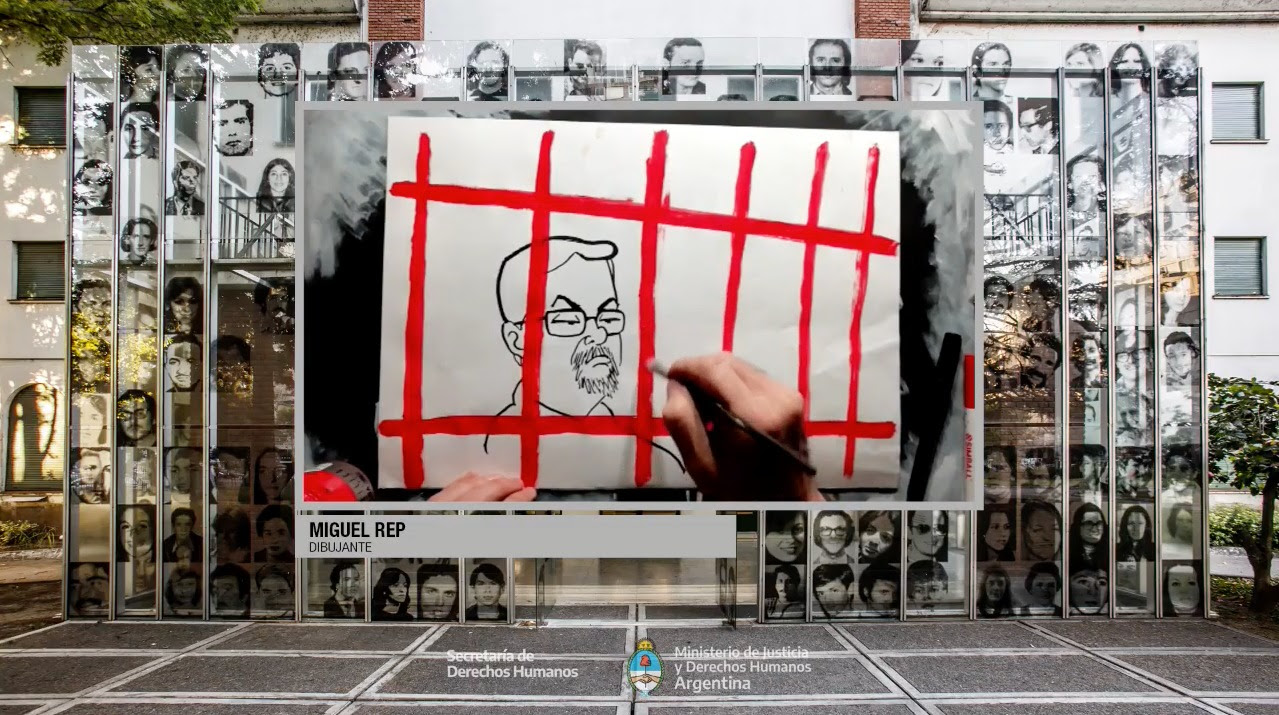By Eric Domergue
Memory is not a verb. Nor an adjective or an adverb.
Memory is a noun.
A noun that conjugates with “Never Again”.
With “No to Impunity”.
With “Do Not Forget”.
With “Trial and Punishment”.
And, every day, it renews those cries they weren’t able to muffle, as they keep cutting through silence, and pass on to younger generations.
Memory is feminine, it’s a Mother and a Grandmother, it’s a white handkerchief, it’s that tireless walk.
Memory is a companion.
ESMA is a Memory of Memories.
It’s hell turned into a Site of Memory
It’s death transformed into life, with its basements and hallways inhabited by 5,000 wandering souls who keep speaking their truths, demanding justice.
Memory is to beat the pest and add a new tour –a virtual one, but a tour nonetheless– to a handful of speakers to remind the world that the ESMA survivors didn’t give up and, on April 30th, 2020, they managed to get the French government to withdraw an Order of Merit they had awarded to a repressor whose first name is Ricardo and his last name is Cavallo.
Ricardo Cavallo.
Corvette Captain. Aka Sérpico. Aka Marcelo. Aka Miguel Ángel.
A soldier within the Task Force 3.3.2 in the field of torture and extermination at the Navy School of Mechanics.
A military attaché at the French Embassy in Argentina, he unsuccessfully hid in Mexico: there, in Aztec land, he was identified as an unpunished repressor, a torturer, a murderer who was extradited to Spain and tried in court by Judge Baltazar Garzón.
ESMA Museum and Site of Memory’s Director Alejandra Naftal found the right words to kick-off the tour. She made a call to prove “that the fight for memory, truth and justice is a collective effort. Memory is the present day”, she said, echoing everyone’s thoughts.
For Horacio Pietragalla, Argentina’s Secretary of Human Rights, “Cavallo is a symbol of the years of impunity, the civilian complicity with the dictatorship, but also the solidarity between countries in order to carry on the search for universal justice”. Kidnapped when he was only five months old, and later a restored grandchild, Pietragalla remembered that “the trial of those responsible for genocide after more than 30 years of impunity is a unique and historic process that covered every military rank, but also the civilian and ecclesiastical responsibility with that dictatorship”.
French Ambassador in Argentina Claudia Scherer-Effosse stressed the fact that ESMA “has become a key place for memory… This tour in particular brings back the memories of Alice Domon and Léonie Duquet, the french nuns who were victims of Alfredo Astiz and Ricardo Cavallo” back in December ‘77. She also explained how her government’s steps resulted in “French Republic president Emmanuel Macron signing a decree that withdrew the honor of the National Order of Merit to repressor Ricardo Cavallo due to his serious offense to honor” on April 30th, 2020.
Sébastien Touzé, Director of the René Cassin Foundation – International Institute of Human Rights, a Member of the United Nations Committee Against Torture, added that “this place that has been the stage of the worst exactions and the most terrible crimes, is today an elevated spot of national memory, but also an emblem for all human rights defenders … It is imperative to know what this place was in order to understand what it is and what it will be, to learn the lessons of history and build human rights, take responsibility for the past in order to offer thousands of victims the right to know, understand, speak out and thus rebuild their lives ”.
Sophie Thonon, a French lawyer with a long history in the defense of victims of the Argentine dictatorship from 1976 to 1983, was actively involved in closely following in the footsteps of Ricardo Cavallo and disarming his lies with which he managed to escape justice for years. And she pondered: “We must never forget that Argentina and Greece are the two best-known cases of countries that just after their dictatorship do what is necessary to prosecute their military juntas in national courts, on the basis of their national law and judges.»
ESMA survivor Juan Gasparini is live memory. He was the first person to report Cavallo’s involvement in ESMA, point out that he had been awarded with the Order of Merit as an Officer and launch a campaign to get that honor withdrawn. And he succeeded. He ended his testimony demanding once again: “Truth, justice, reparation, assurances of no-repetition, and memorialization. This cannot be forgotten”.
Miguel Rep didn’t need words, he just used his steady strokes to draw the face of disgrace, the cages of justice, the thousand faces of memory.
Memoria is snatching that medal of Merit off from such an unworthy chest.
Memoria was, is and will continue to be “ Do Not Forget”.
Don’t forget the victims.
Don’t forget the victimizers.
And have them, like Cavallo, spend their days and nights in prison.
Memory –as it was stated– is a lot more than a noun.
It conjugates with those who multiply –at the ESMA Site of memory and every corner of the country– the voices of the people who are no longer with us.
But they remain in our memory.
And our fight.
(In Memory of Víctor Basterra)


